| |
Glossary of Coral Reef Terminology - B
B lymphocyte - a type of white blood cell which produces antibodies |
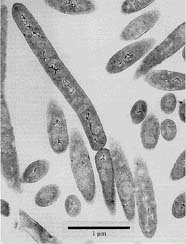
Image of rod-shaped bacterium, Bacillus infernus, collected from deep (20-2800 meters) terrestrial subsurface. (Photo: U.S. Dept. of Energy/Subsurface Microbial Culture Collection)
|
bacillus - a bacterium with a rod-like shape |
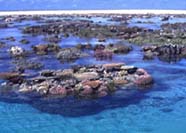
Emergent coral heads in a back reef zone. (Photo: Great Barrier Reef Marine Park Authority)
|
back reef - the shoreward side of a reef, including the area and sediments between the reefcrest/algal ridge and the land. It corresponds to the reef flat and lagoon of a barrier reef and platform margin reef systems |
backcross - crossing an organism with one of its parents, or with the genetically equivalent organism. The offspring of such a cross are referred to as the backcross generation or backcross progeny |
background extinction - the continuous, low-level extinction of species that has occurred throughout much of biological history |
background level - the concentration or level of a substance or other factor in an environment that is not the result of human activities, e.g., background levels of chemicals, light, sound, etc |
background noise - noise coming from sources other than the noise source being monitored |
backscatter - the deflection of acoustic radiation in a scattering process through an angle greater than 90 degrees. Backscatter is the term commonly used to describe the return of energy from the seabed to the receiver in an active sonar |
bacteria - a major group of living organisms in the kingdom Monera. They are microscopic and mostly unicellular, with a relatively simple cell structure lacking a cell nucleus, cytoskeleton, and organelles such as mitochondria and chloroplasts. Bacteria are genetically distinct from protists, fungi, plants, and animals. Many species of bacteria are pathogenic to other organisms, including humans |
bacterial bleaching - loss of zooxanthellae with resultant bleaching caused by a specific bacterial infection, as opposed to environmental stress. The bacteria (Vibrio sp.) produce a toxin which cause lysis of the zooxanthellae. |
bacterial chlorophyll - chlorophylls (bacteriochlorophylls a, b, c, d, e, and g) found in photosynthetic bacteria. They differ from plant chlorophyll in chemical construction and absorption spectra characteristics |
bacterial generation time - the time interval required for a bacterial cell to divide, or for a population of bacterial cells to double. Generation times for bacterial species growing in nature may be as short as 15 minutes or as long as several days |
bactericide (bacteriocide) - a substance that kills bacteria |
bacteriocyte - a cell which harbors symbiotic bacteria in animals as diverse as insects and marine tube worms living around hydrothermal vents |
bacteriophage (phage) - a virus that attacks and infects bacterial cells. Phages consist of a protein coat enclosing the genetic material, DNA or RNA, that is injected into the bacterium. Upon infection, synthesis of host DNA, RNA and proteins ceases and the phage genome is used to direct the synthesis of phage nucleic acids and proteins using the host's transcriptional and translational apparatus |
bacteriophagous - feeding on bacteria |
baffling - to impede the force or movement of flowing water, such that sediment particles may settle from suspension |
bailer - an exopod of the maxilla of decapod crustaceans, such as lobsters, that functions in regulating the flow of water in the gill chamber |
balanced polymorphism - a type of polymorphism in which the frequencies of the coexisting forms do not change noticeably over many generations |
Baldwin effect - a hypothesis in which a characteristic, such as individual learning, significantly affects the evolution of the species with respect to that characteristic. The Baldwin effect functions in two steps. First, phenotypic plasticity (the ability of an organism to adjust to its environment during the course of its lifetime) allows an individual to adjust to a partially successful mutation, which might otherwise be utterly useless to the individual. If this mutation adds to inclusive fitness, it will succeed and proliferate in the population |
ballast - a weight at the bottom of the boat to help keep it stable. Ballast can be placed inside the hull of the boat or externally in a keel. Water picked up as ballast in one location may be released in another, and in doing so, may introduce non-native species |
bamboo coral - an octocoral found in both warm, shallow-water and cold, deep-water marine habitats throughout the world's oceans. Bamboo corals possess a skeletal arrangement which resembles bamboo. The skeleton is composed of calcareous plates and proteinaceous gorgonin. They can live for centuries |
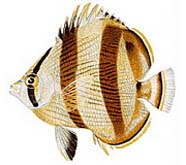
Chaetodon striatus, the banded butterfly fish, has two black bands of pigment encircling its body. (Image: NOAA)
|
band - a thick, pigmented vertical marking that encircles the circumference of an organism's body |
bank - a broad elevation of the sea floor around which the water is relatively shallow but not a hazard to surface navigation |
bank reef - large reef growths, generally having irregular shape, which develop over submerged highs of tectonic or other origin and are surrounded by deeper waters |
bank/shelf - deepwater area extending offshore from the seaward edge of the fore reef to the beginning of the escarpment where the insular shelf drops off to the deep, oceanic water. If no reef crest is present, it is the flattened platform between the fore reef and the deep ocean waters or between the intertidal zone and open ocean |
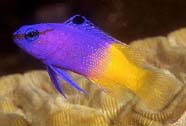
The royal gramma, Gramma loreto, has a darkly pigmented bar across its eye.
|
bar - a thick, pigmented vertical marking that does not encircle the body of an organism; an elongate submarine shoal |
bar - unit of pressure of one million dynes per square centimeter |
bar and spit - a low accumulation of sand or sediments forming an intertidal or subtidal extension of a reef islet |
bar-built estuary - an estuary formed when a barrier island or sand bar separates a section of the coast where fresh water enters |

Stingrays have whip-like tails, defensively armed with a venemous barb which can inflict a serious wound on another animal (Photo: Peter Piermarini, Ph.D.)
|
barb - a type of spine armed with teeth pointing backwards |
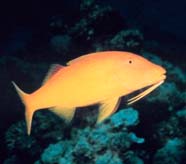
A yellow goatfish with two prominent barbels protruding from its chin. (Photo: NOAA)
|
barbel - a slender elongate sensory structure protruding from the lips or jaws of certain fishes, such as catfishes, goatfishes, drums, cods, and many deep-sea fishes. Barbels may appear singly or in groups. They are primarily tactile in function but may also bear tastebuds, allowing the fish to taste its environment |
Barcode of Life Data System (BOLD) - an online system that aids in the collection, management, analysis, and use of DNA barcodes. BOLD was created and is maintained by the University of Guelph in Ontario |
barcode; barcoding - a technique for characterizing species of organisms using a short DNA sequence from a standard and agreed-upon position in the genome. The cytochrome c oxidase subunit 1 mitochondrial region is emerging as the standard barcode region for higher animals. It is 648 nucleotide base pairs long in most groups |
baroceptor - a sensory organ perceiving changes in pressure; also called "baroreceptor" |
barometer - an instrument for measuring air pressure |
barophile - a microorganism which grows best (or can only grow) in high-pressure environments, such as deep-sea environments |
barotrauma - an injury that results from rapid or extreme changes in pressure. Scuba divers may experience ear barotrauma, a condition of discomfort in the ear caused by pressure differences between the inside and the outside of the eardrum |
barotropism - a response to pressure stimuli |
barren zone - the region of a coral reef seaward of the lower palmata zone and just landward of the buttress or mixed zone |

Cape Lookout National Seashore currently consists of 4 barrier islands. (Photo: U.S. National Park Service)
|
barrier island - a long, usually narrow accumulation of sand, that is separated from the mainland by open water (lagoons, bays, and estuaries) or by salt marshes |
barrier net - a small-mesh net used to capture coral reef or coastal pelagic fishes |
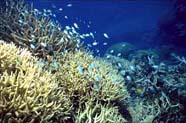
Healthy Acropora coral in Australia's Great Barrier Reef. (Photo: Ray Berkelmans/Great Barrier Reef �Marine Park Authority)�
|
barrier reef - a long, narrow coral reef, roughly parallel to the shore and separated from it by a lagoon of considerable depth and width. It may lie a great distance from a continental coast. It is often interrupted by passes or channels |
basal - of, at or forming a base |
basal bud - in bryozoans, the bud arising from the basal wall of the parent zooid |
basal plate - lower part of the coral cup, separating the polyp from the substratum. A synonym of pedal disc |
basalt - a dark, fine-grained igneous rock composed of minerals rich in ferromagnesian silicates |
base - a substance that reduces the hydrogen ion concentration in a solution |
base - in genomics, a key component of DNA and RNA molecules. Four different bases are found in DNA: adenine (A), cytosine (C), guanine (G) and thymine (T). In RNA, uracil (U) substitutes for thymine; also known as nitrogenous bases; a base, a phosphate molecule and a sugar joined together constitute a nucleotide |

Diagram of a DNA molecule. (Diagram: U.S. NIH/Human Genome Project)
|
base pair - two nitrogenous bases which form a "rung of the DNA ladder." A DNA nucleotide is made of a molecule of sugar, a molecule of phosphoric acid, and a base molecule. The bases are the "letters" that spell out the genetic code. In DNA, the code letters are A, T, G, and C, which stand for the chemicals adenine, thymine, guanine, and cytosine, respectively. In base pairing, adenine always pairs with thymine, and guanine always pairs with cytosine. In RNA, thymine is replaced by uracil |
base sequence - the order of nucleotide bases in a DNA molecule |
baseline data - a quantitative level or value from which other data and observations of a comparable nature are referenced |
basement rock - a complex of metamorphic and igneous rocks that underlies sedimentary deposits. These are the oldest rocks in a given area |
basic research - research conducted with the sole goal of obtaining knowledge; in contrast with applied research |
basicaudal - on the base of the caudal fin of fishes |
basicaudal spot - a spot on the base of the caudal fin, common in many unrelated fish species |
basilar - forming a foundation |
basin - any large depression in which sediments are deposited |
basionym - In taxonomy, the first name published for a taxon. It remains the defining name for the taxon even when the taxon has been transferred to a new combination. According to priority rules of biological nommenclature, after a taxonomic revision that results in a species being reclassified in another genus, the specific epithet must remain the same as the one in the basionym |
basipinacocyte - a pinacocyte that adheres a sponge to a substrate by the external secretion of a collagenous matrix |
basitrichous isorhiza - an isorhizal cnidocyst (nematocyst) with spines at the base of the tube only; also called "basitrich" |
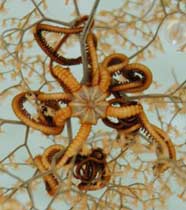
The spiny arms of this basket star branch repeatedly to form a coiled mass. Unlike other brittle-stars, basket stars are suspension feeders, trapping large particles in their extended arms.(Photo: NOAA ocean Explorer/ L. Mullineaux)
|
basket star - a basket star is a specialized type of brittle star (Echinodermata). It has a series of complexly branched arms which are used to capture plankton |
Batesian mimicry - a type of mimicry in which a harmless species resembles a different species that is unpalatable, poisonous, or otherwise noxious or harmful to a predator |
bathyal zone - region of the seafloor from the shelf edge (200m) to the start of the abyssal zone (2,000m) |
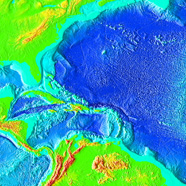
A bathymetric map of the Caribbean Sea and adjacent regions. (Map: NOAA/NGDC)
|
bathymetric map - a map which delineates the form of the bottom of a body of water by the use of depth contours (isobaths) |
bathymetry - the science of measuring ocean depths to determine the topography of the sea floor |
bathypelagic zone - a layer (zone) of the ocean which lies just beneath the mesopelagic zone. It extends from 1000-4000 meters. Because no light (except for bioluminescence) penetrates this zone, it is also called the midnight zone. The temperature in the bathypelagic zone remains fairly constantat about 4 degrees C |
battery - a group of nematocysts on the tentacles of hydras and some other hydroid polyps |
baud - unit of data transmission speed of one bit per second |
Bayesian inference - a statistical inference in which evidence or observations are used to update or to newly infer the probability that a hypothesis may be true. It uses aspects of the scientific method, which involves collecting evidence that is meant to be consistent or inconsistent with a given hypothesis. As evidence accumulates, the degree of belief in a hypothesis ought to change. With enough evidence, it should become very high or very low. Thus, proponents of Bayesian inference say that it can be used to discriminate between conflicting hypotheses: hypotheses with very high support should be accepted as true and those with very low support should be rejected as false |

A buoyancy control devise (BCD). It is a vest-like expandable bladder that can be inflated with air to increase or decrease a scuba diver's buoyancy while diving.
|
BCD (buoyancy control device) - the BCD is a mandatory piece of equipment for SCUBA diving. It is an expandable bladder, most commonly worn as an expandable vest, that can be inflated with air from the tank to increase buoyancy while diving. To decrease buoyancy, the BCD is deflated through special air-dump valves or hoses. It provides positive buoyancy for resting, swimming or lending assistance to others under water. The BCD allows maintenance of neutral buoyancy at any depth simply by adding or releasing air. It is also called a buoyancy compensator (BC) |
beach - an aggregation of unconsolidated sediment, usually sand, that covers the shore |
beak - in cephalopods, one of two chitinous mandibles (jaws) used primarily to cut prey tissues during feeding |
beam - the widest part of a vessel |
Beaufort scale - a scale used to classify wind speeds, devised in 1805 by Admiral Francis Beaufort of the British Navy |

Image of the commercially harvested -beche de mer+.
|
beche-de-Mer - commercially harvested sea cucumbers (Class Holothuroidea). In Asia, it is considered to be a delicacy |
bedded - stratified; deposited or arranged in horizontal layers, as in stratified rock |
bedload - sedimentary material subject to transport by flowing water, e.g. currents. The size of particles moved is proportional to the strength of the water movement |
bedrock - the solid rock of the earth's crust that lies under the soil and other unconsolidated earth materials |
behavioral isolating mechanism - a difference in behavior (usually reproductive behavior) that prevents genetic exchange between members of different populations or species |
bel - unit of noise intensity equal to ten decibels |
Belau - traditional (native) name for Palau (Republic of Palau) |
belt transect - a linear or circular transect with the observation area being a specified distance on either side of the transect line |
benchmark - a measurement or standard that serves as a point of reference by which process performance is measured |
benign introduction - the purposeful introduction of members of a species into an appropriate habitat, foreign to the "home" habitat or area, for the purposes of conservation of that species |

Bottom-dwelling flounders are members of marine benthic communities. (Photo: Passage Productions)
|
benthic - bottom dwelling; living on or under the sediments or other substrate |
benthic carbon dioxide flux - the amount of carbon dioxide (CO2) released from a unit area of sediment over a specific time interval, during the decomposition of organic matter. Part of the benthic CO2 flux may also result from the dissolution of calcium carbonate |
benthic chamber - an open-bottom container (usually constructed of acrilic) that encloses an area of sediment/substratum and overlying water. The chamber is deployed to capture gas (e.g., efflux of CO2 from sediments) and solute movement between the sediment and the water column |
Benthic Habitat Viewer (BHV) database - a database developed and managed by the National Centers for Coastal Ocean Science (NCCOS/NOAA).The BHV provides easy access to a large database of underwater imagery characterizing coral reef organisms and habitats |
benthic organism (benthos) - an organism whose habitat is on or near the bottom of a stream, lake, or ocean |

A benthic crab (phylum Arthropoda).
|
benthic region - the bottom layer of a body of water |
benthic-pelagic coupling - the cycling of nutrients between bottom sediments and the overlying water column |
berm - a low, incipient, nearly horizontal or landward-sloping area, or the landward side of a beach, usually composed of sand deposited by wave action; a mound of earth formed to control the flow of surface water; a sloped wall or embankment used to prevent the inflow or outflow of materials into/from an area |
beta animal - in animal behavior, the subordinate or second animal in a social group |
beta particle - a high-speed particle, identical to an electron, emitted from an atomic nucleus |
beta taxonomy - in taxonomy, the process of arranging taxa into higher categories which reflect the evolutionary history of a group of organisms. |
bias - a tendency or preference towards a particular perspective or result; in statistics, an inadequacy in experimental design that leads to results or conclusions not representative of the population under study; the consistent or systematic underestimation or overestimation of a true value, because of preconceived notion of the person sampling the population |
bicarbonate - any salt containing the HCO3 anion |
bicentric distribution - the presence of a species (or other taxonomic unit) in two widely separated geographic areas |
bicornate - having two horns or horn-shaped structures |
bicuspid - having two cusps or points |
biennial - occurring once every two years |
bifacial - having like opposite surfaces; describes plates which have corallites on both sides |
bifid - divided or cleft into two parts or lobes |
bifurcate - a coral branch that divides into two equal branches |
bigeminal - occurring in pairs |
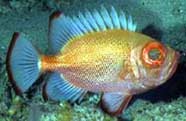
The short bigeye, Pristigenys alta, photographed at Pulley Ridge (Photo: U.S. Geological Survey)
|
bigeye - any species of bony fishes in the family Priacanthidae. Bigeyes ( also called "catalufas") are most typically colored bright red, but other coloration patterns exist. The common name of "bigeye" refers to their unusually large eyes which are adapted their |
bight - an indentation of the coast forming a large open bay |
bilateral symmetry - a bilaterally symmetric organism is one that is symmetric about a plane running from its frontal end to its caudal end (head to tail), and has nearly identical right and left halves. Most animals are bilaterally symmetrical. The exceptions are sponges (no symmetry), cnidarian polyps and medusae, and ctenophores (radial symmetry), and echinoderms (partial radial symmetry). |
Bilateria - group containing all multicellular animals with bilateral symmetry; the name has no taxonomic status |
bilineate - having two lines |
bimaculate - having two spots |

Chart showing a population of data having a bimodal distribution.
|
bimodal - a distribution in which the frequency curve has two peaks. A single peak is called a mode |
bimodal curve - a frequency curve characterized by two peaks |
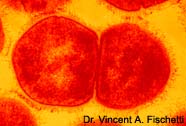
A bacterial cell reproducing by binary fission. The two resultant daughter cells are genetically identical. (Photo: Dr. Vincent A. Fischetti, Laboratory of Bacterial Pathogenesis and Immunology, Rockefeller University)
|
binary fission - type of cell division found in prokaryotic cells, in which dividing daughter cells each receive a copy of the parental chromosome |
binding - the ability of molecules to stick to each other because of the exact shape and chemical nature of parts of their surfaces |
binding site - the reactive part of a macromolecule that directly participates in its specific combination with another molecule |
binomen - a two-part name given to a species in which the first part is the name of the genus and the second is the specific name |
binomial nomenclature - a system of nomenclature where each animal has a dual name consisting of genus and species, e.g., the boulder coral, Montastrea annularis |
bioaccumulation - the buildup of chemical substances in the cells or tissues of an organism |
bioacoustics - a discipline of zoology that is concerned with sounds of biological origin: their mechanisms of production, physical properties, receptors and reception physiology, and the role of the sounds in behavior |
bioassay - an assay for the activity or potency of a substance that involves testing its activity on living materials |
biochemical - a product produced by chemical reactions in living organisms |
biochemical cycle - the flow of an element through the living tissue and physical environment of an ecosystem, e.g., the carbon, hydrogen, oxygen, nitrogen, sulfur, and phosphorus cycles |
biochemical genetics - the study of the relationships between genes and enzymes, specifically the role of genes in controlling the steps in biochemical pathways |
biochemical oxygen demand (BOD) - the amount of oxygen taken up by microorganisms that decompose organic waste matter in water. It is therefore used as a measure of the amount of certain types of organic pollutant in water. A high BOD indicates the presence of a large number of microorganisms, which suggests a high level of pollution |
biochip - an electronic device that uses organic molecules to form a semiconductor; a microchip that uses tiny strands of DNA to latch onto and quickly recognize thousands of genes at a time; collection of miniaturized test sites (microarrays) arranged on a solid substrate that permits many tests to be performed at the same time in order to achieve higher throughput and speed. A biochip can perform thousands of biological reactions, such as decoding genes, in a few seconds. Biochips can also be used to rapidly detect chemical agents used in biological warfare so that defensive measures can be taken |
biochore - a group of similar biotopes |
bioclastic sediment - a sediment type composed of fragments of organic skeletal materials |
biocoenose - an assemblage of diverse organisms inhabiting a common biotope |
biocoenosis - a community or natural assemblage of organisms. The term often is used as an alternative to ecosystem, but strictly it is the fauna/flora association excluding physical aspects of the environment |
biocriteria (biological criteria) - as defined by the U.S. Environmental Protection Agency (EPA), biocriteria are powerful management tools because biological communities are dependable indicators of the health of an aquatic ecosystem. The criteria are generated as narrative descriptions or numeric values that represent the biological condition of the community. Rigorous biological assessments are needed to identify metrics for a monitoring program and to set expectations for the water body. These are used to develop a scoring system to indicate the health of the water body and to develop biocriteria for each class or designated use |
biocycle - a subdivision of the biosphere, e.g., a biochore |
biodegradable - capable of undergoing rapid decomposition by microorganisms under aerobic and/or anaerobic conditions. Most organic materials are biodegradable |
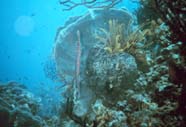
A coral reef contains a great variety of species of all major kingdoms of living forms. (Photo: Dr. Anthony Picciolo)
|
biodiversity - the total diversity and variability of living things and of the systems of which they are a part. This includes the total range of variation in and variability among systems and organisms at the bioregional, ecosystem and habitat levels, at the various organismal levels down to species, populations and individuals and at the level of the population and genes |
Biodiversity Conservation Information System (BCIS) - The purpose of the BCIS Framework for Information Sharing is to support BCIS Members and others making decisions on the conservation and sustainable use of living resources. BCIS is a consortium of ten international conservation organizations and programs of IUCN—The World Conservation Union. BCIS Members collectively represent the single greatest global source of biodiversity conservation information in the world. BCIS is a framework within which the Members’ networks work together toward a common goal: to support environmentally sound decision-making and action by facilitating access to biodiversity data and information |
biodiversity hot spot - an area that features exceptional concentrations of species, including many endemics. Many such hot spots also experience large habitat losses, putting these ecosystems at risk |
biodiversity indicators - in conservation biology, sets of species or taxa whose presence may indicate areas of high species richness |
bioenergy - energy made available by the combustion of materials derived from biological sources |
bioerosion - erosion of the physical/geological environment by organism activities such as boring, scraping, etching, etc. |
biogenesis - a central concept of biology that all living organisms are descended from predecessor living organisms |
biogenic - refers to things which came about as a result of the activities of living organisms |
biogenic reef - a mound-like layered structure built by and predominantly composed of organic remains such as shells and skeletons of sedentary organisms |
biogenic rock - an organic rock produced by the physiological activities of plants or animals |
biogenous - produced by living organisms |
biogenous sediment - sediment that is composed of the skeletons and shells of marine organisms, primarily plankton |
biogeochemical cycle - the chemical interactions among the atmosphere, biosphere, hydrosphere, and lithosphere |
biogeographical filter - a geographic or ecological barrier that restricts some dispersal between regions and blocks passage of certain forms but not others |
biogeography - a branch of biology that deals with the geographical distribution of organisms |
bioherm - a body of rock built up by or composed mainly of sedentary organisms, e.g., hard corals, calcareous algae or mollusks, and enclosed or surrounded by rock of different origin |
bioinformatics - the analysis of biological information using computers and statistical techniques; the science of developing and utilizing computer databases and algorithms to accelerate and enhance biological research. Bioinformatics is particularly important as an adjunct to genomics research, because of the large volume of complex data generated |
biolimiting - relating to the environmental factors determining or restricting the growth of a particular life form |
biolistics - a technique to insert DNA into cells. The DNA is mixed with small metal particles, usually tungsten or gold, a fraction of a micrometer across. These are then fired into a cell at very high speed. |
biological clock - an internal biological mechanism which controls certain biological rhythms and biocycles, such as metabolism, sleep cycles, and photosynthesis |
biological control - the use of living organisms, such as parasites, disease agents, and predators, to control or eliminate other unwanted living organisms, rather than by using toxic chemicals or other means of elimination |
Biological Data Profile of the Content Standard for Digital Geospatial Metadata - provides a common set of terminology and definitions for the documentation of biological data through the creation of extended elements and a profile of the FGDC Content Standard for Digital Geospatial Metadata. Its purpose is to provide a user-defined or theme-specific profile of the FGDC Content Standard for Digital Geospatial Metadata to increase its utility for documenting biological resources data and information. This standard can be used to specify metadata content for the full range of biological resources data and information. It also serves as the metadata content standard for the National Biological Information Infrastructure (NBII) |
biological half-life - the time required for one-half of the total amount of a particular substance in a biological system to be consumed or broken down by biological processes when the rate of removal is approximately exponential. Toxic chemicals with a long biological half-life will tend to accumulate in the body and are more likely to be harmful. A substance with a short biological half-life may still accumulate if a portion of it it becomes tightly bound to bone or other tissues, even if most of it is quickly eliminated from the body |
biological indicator - an organism, species or community whose characteristics show the presence of specific environmental conditions. Other terms used are indicator organism, indicator plant and indicator species |
biological marker - a measurable and quantifiable biological parameter which serves as an index for health and physiology related assessments, such as disease risk, environmental exposure and its effects, disease diagnosis, metabolic processes, and epidemiologic studies; also called "biomarker" |
biological navigation - the ability of certain animals to navigate by instinct to specific sites. Depending upon the species, the cues involved may be related to star patterns, sun angle, polarized light, chemical scents or tastes, or the Earth's magnetic field |
biological productivity - the amount of organic matter, carbon, or energy content that is accumulated during a given time period |
biological rank - in animal behavior, when a hierarchy of dominance exists between different species which compete for food, water or space |
biological rhythm - an overt, measurable activity generated by some internal oscillator (or ‘clock’) |
biological survey - collecting, processing, and analyzing a representative portion of the resident aquatic community to determine its structural and/or functional characteristics |
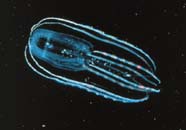
A bioluminescent comb jelly of the phylum Ctenophora.
|
bioluminescence - light produced by organisms as a result of conversion of chemical energy to light energy |
biomagnification - the accumulation and amplification of chemical substances at each succeeding trophic level |
biomarker - a molecular marker associated with a biological function; a physical, functional, or biochemical indicator (eg, the presence of a particular metabolite) of a physiological or disease process; a chemical compound produced by a specific organism that can be used as an indicator for the presence of that organism |
biomass - an estimate of the amount of living matter per some unit volume or area |
biome - a community of animals and plants occupying a climatically uniform area on a continental scale |
biometrics - the use of statistics for the study of biological events |
biopharming - to genetically engineer an organism to produce a pharmaceutical drug, vaccine or industrial substance |
biophysics - the scientific study of the physics of organisms, their biological structure and processes |
biopolymer - a macromolecule, including nucleic acids, proteins, and polysaccharides, which is formed by a living organism |
bioregion - any geographical region characterized by a distinctive biota |
bioremediation - the use of organisms such as plants or microorganisms to aid in removing hazardous substances from an area |
BiorockTM - Biorock Technology, or mineral accretion technology is a method that applies safe, low voltage electrical currents through seawater, causing dissolved minerals to crystallize on structures, growing into a white limestone similar to that which naturally makes up coral reefs. This material has a strength similar to concrete. It can be used to make robust artificial reefs on which corals grow at very rapid rates. The Biorock Process is owned by Biorock, Inc; see also "mineral accretion" in this glossary |
biosphere - the thin region surrounding the Earth that is capable of supporting life |
biostrome - a horizontally-bedded calcareous stratum of fossilized remains of sedentary organisms; a flat, thin reef-like limestone structure consisting predominantly of marine fossils |
biosynthesis - a metabolic process where chemical compounds are produced from simpler reagents. Biosynthesis is a cellular process which occurs within living organisms and is generally catalyzed by enzymes. The process is a vital part of metabolism |
biota - all life forms of a given area |
biotechnology - biological techniques used in applied research research and product development. In particular, the use by industry of recombinant DNA, cell fusion, and new bioprocessing techniques; any technology that is applied to living organisms to make them more valuable to humans |
biotic potential - the maximum rate a population can increase under ideal conditions |
biotope - an area of relatively uniform environmental conditions, occupied by a given plant community and its associated animal community |
biotoxin - any poisonous or venemous substance produced by any living organism |
bioturbation - the rearrangement of sediments by organisms that burrow through them and ingest them |
bioturbator - an organism, mainly a worm or crustacean, that disturbs sediments by burrowing or feeding. Its activities mix the sediment layers and may cause substantial resuspension |
biotype - a physiological variety or a group of individuals having distinctive genetic characters in common |
biparental - the situation where the young are raised by both parents |
bipectinate - having two margins which are toothed, like a comb; descriptive of the gills (ctenidia) of aquatic mollusks |
bipectinate gill (ctenidium) - in mollusks, refers to having gill lamellae on both sides of the ctenidial axis |

Mature bipinnaria of Pisaster ochraceus, ca 24 days old, raised in culture by T.H.J. Gilmour. (Photo: University of Saskatchewan Archives)
|
bipinnaria larva - an early starfish larva with ciliated bands running about the periphery |
biradial symmetry - a body plan in some cnidarians that has two planes of symmetry rather than the several planes of a radially symmetrical animal, or the single plane of a bilaterally symmetrical one. Both planes of symmetry are longitudinal and are at right angles to each other. Both include the aboral-oral axis, which is the axis of symmetry |
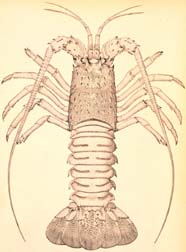
Note the biramous antennules of the spiny lobster.
|
biramous appendage - a type of appendage that is characteristic of crustaceans. It forks from the basal protopodite to form two branches, the inner endopodite and the outer exopodite. Each of these branches can be composed of either one or more segments. There are many variations on this generalized structure; the branches often possess highly specialized extensions |
bit - the smallest unit of information that a computer can store and process. A bit has two possible values, 0 or 1, which can be interpreted as yes/no, true/false, or on/off |
bitmap - a format for storing graphics in an uncompressed manner |
bitmap image - also called raster or paint images. They are made of individual dots called pixels (picture elements) that are arranged and colored differently to form a pattern. Compared to a vector image, bitmap images are great for photographs because they tend to offer greater subtleties for shading and texture but require more memory and take longer to print. Vector images are best for drawings that need sharper lines, more detail, and easy modification. Vector images require far less printing resources than bitmap images |
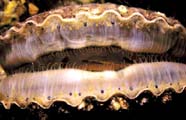
A scallop (class Bivalvia) displays its rows of light-sensitive eyespots.
|
Bivalvia (Pelecypoda) - a class of Mollusca that includes clams, oysters and mussels. Bivalves are laterally compressed and possess a shell composed of two valves that hinge dorsally and enclose the body. They are common inhabitants of coral reefs |
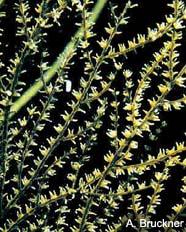
Black coral isn't really black. The name refers to the black color of their proteinaceous skeletons. The living colonies are made up of thousands of tiny coral polyps whose colors may be yellow, green or orange. (Photo: Dr. A. Bruckner, NOAA)
|
black coral - black corals are colonial cnidarians in the Order Antipatharia. They are found throughout the world+s oceans, but are most common in tropical deep water habitats from 30-80 m depth. These species of black coral have rigid, erect skeletons that form branched, bush-like colonies. Black coral is commercially harvested primarily for jewelry, and may be globally threatened in many parts of the world as a result of over-harvesting |
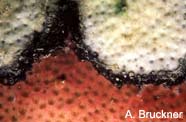
Black band disease. (Photo: Dr. A. Bruckner, NOAA)
|
black-band disease - a world-wide disease of corals that is characterized by a dark ring, or band, that separates apparently healthy coral tissue from freshly exposed coral skeleton. It migrates across coral colonies and completely degrades coral tissue. The infecting agent is a synergestic assortment of photosynthetic and non-photosynthetic bacteria. |
bladder - any sac or cavity used to store liquids or gases |
blade - a leaf-like structure |
blastocoel - the fluid-filled cavity formed within the mass of cells of the blastula of many animals during the later stages of cleavage |
blastocyst - a preimplantation embryo. The blastocyst consists of a sphere made up of an outer layer of cells (trophectoderm), a fluid-filled cavity (blastocoel), and a cluster of cells on the interior (inner cell mass) |
blastomere - an undifferentiated cell of a cleaving embryo, and of the morula and blastula stages of embryonic development |
blastopore - the opening into the archenteron (primitive gut) of a gastrula. In some animals it develops into the mouth and, in others, into the anus |
blastostyle - the axial portion of a modified gonangium, upon which medusoid buds are developed |
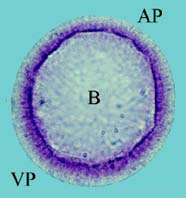
A late blastula characterized by a single layer of cells surrounding the central hollow area - the blastocoel (B). The blastomeres at the vegetal pole (VP) are taller than those at the animal pole (AP), making the vegetal pole appear slightly thicker. (Photo: Cell and Developmental Biology Online website (University of Guelph); URL: http://www.uoguelph.ca/zoology/devobio/)
|
blastula - a stage of embryonic development of animals near the end of cleavage (cell division), but before gastrulation. In animals where cleavage involves the whole egg, the blastula usually consists of a hollow ball of cells (blastomeres) surrounding a fluid-filled central cavity, the blastocoel |
bleach - to make or become white or colorless by means of chemicals, by exposure to solar radiation, etc. In corals, the reduction in intensity or complete absence of coloration within living coral tissues, due to expulsion of symbiotic algae (zooxanthellae) |
bleaching index - index based on the strength and duration of local HotSpots to monitor bleaching events |
bleaching outbreaks - development of bleaching events |
bleaching stressors - environment-induced stress that results in bleaching, e.g., disease, excessive or insufficient light, increased levels of ultraviolet radiation, sedimentation, pollution, salinity changes, and increased temperatures |

The blenny, Blenniella gibbifrons, is common on Hawaiian shallow reefs living in empty vermetid tubes (Photo: Keoki and Yuko Stender)
|
blenny - the common name of a large group of over 800 species within seven families of bony fishes in the suborder Blennioidei. Blennies are small, usually scaleless fishes with comb-like teeth living in coastal and coral reef areas, including seagrass beds and tidepools. At least one species lives in fresh water. Most are are characterized by possessing blunt foreheads, elongated, tapering bodies, and a continuous long dorsal fin. The pelvic fins are usually anterior to the pelvic fins, and in the jugular in position. Many species are cryptic or inhabit the surge zone. Most are herbivores |
blind test - a method of testing or experimentation, in which an independent observer records the results of any test, drug, placebo, or procedure without knowing the identity of the samples or what result might be expected |
blog (weB LOG) - basically a journal that is available on the web. The activity of updating a blog is "blogging" and someone who keeps a blog is a "blogger" |
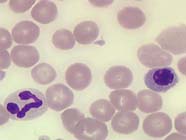
Red and white blood cells. The white blood cells are the larger ones with irregular nuclei.The small particles are platelets. (Photo: U.S. National Institutes of Health)
|
blood - a circulating tissue composed of a fluid portion (plasma) with suspended formed elements (red blood cells, white blood cells, and platelets) that delivers nutrients and hormones to cells and removes wastes; In some invertebrates, the blood is called the haemolymph |
blood pigment - a pigment used by an organism to transport oxygen efficiently, usually in a circulatory system (e.g., hemoglobin, hemocyanin) |
blood sinus - in invertebrates, a space among the muscles and viscera through which blood returns to the blood-pumping organ (heart) |
blood sinus - a channel, not a blood vessel, which permits the passage of blood |
bloodworm - a marine polychaete worm used as bait in angling |
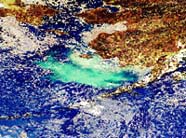
A SeaWiFS (Sea-viewing Wide Field-of-view Sensor) image of a coccolithophore bloom in the Bering Sea.
|
bloom - a sudden increase in the biomass of phytoplankton or benthic algae in a given area |

The blotch-necked moray (Gymnothorax margaritophorus) from American Samoa bears darkly pigmented blotches along its body. (Photo: NPS, Copyright Richard C. Wass)
|
blotch - a patch or a spot of pigment with irregular edges |
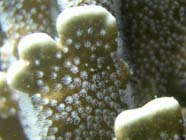
Blue coral (Heliopora coerulea) from American Samoa. (Photo: NPS, Eva DiDonato)
|
blue coral - the blue coral, Heliopora coerulea, is an octocoral that has a massive aragonite skeleton and is an important reef builder in some areas |
Blue List species - registers of those Red List species that show an overall stabilization or increase in abundance in the region considered; Blue List species are considered to be vulnerable and "at risk", but not yet endangered or threatened. Populations of these species may not be in decline, but their habitat requirements are such that they are vulnerable to further disturbances; Blue Lists are mostly a subset of the Red Lists |
Blue Ventures - a not-for-profit organization (UK) which facilitates projects and expeditions that enhance global marine conservation and research. It coordinates expeditions consisting of scientists and volunteers working with local biologists, governmental departments, NGOs and local communities, to carry out research, environmental awareness, and conservation programs at threatened marine habitats around the world |

Blue-green algae (Cyanobacteria). (Photo: J. Waterbury, Woods Hole/NASA Astrobiology Institute)
|
blue-green algae - the former name for the blue-green bacteria, now classified as Cyanobacteria. A group of prokaryotic cells that use chlorophyll on intracytoplasmic membranes for photosynthesis. The blue green color is due to the presence of phycobiliproteins. they occur as single cells, colonies or simple filaments |
BOD (Biological (or Biochemical) Oxygen Demand) - the oxygen used in meeting the metabolic needs of aerobic microorganisms in water rich in organic matter (as water polluted by sewage) |
body wall - the layers of tissue (epidermis, mesoglea, and gastrodermis) that make up the body of a cidarian polyp. The body wall surrounds the gastrovascular spaces |
bond - a physicochemical association between atoms |
bond energy - the energy required to form a particular chemical bond |
booby - the common name for large, streamlined sea birds of the family Sulidae. tropical and subtropical members of the family are called boobies; those of northern waters are called gannets. Gannets have strong migration tendencies, while the boobies do not |
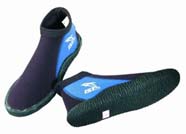
A pair of booties worn by scuba divers under an open-heeled fin.
|
booties - short "boots" usually made of neoprene, worn inside open-heeled fins. they protect a scuba diver's feet from rubbing against the fins while swimming, as well as protecting the entire foot while walking to and from a dive site. Booties also provide warmth |
bootstrapping - a statistical technique based on repeated random sampling with replacement from an original sample to provide a collection of new pseudoreplicate samples, from which sampling variance can be estimated |
borer - an invertebrate that bores into wood, stone, coral, or another animal's shell |
boring sponge - a sponge that chemically digests the limestone skeletons of corals during its search for food and living space, which breaks down the structure of the reef |
boss - a columnar, flat-topped coral-algal growth or erosion structure usually found on the upper surfaces of spurs and buttresses |
bosselated - covered with small, knob-like projections |
BotCam (bottom camera station) - a deep water camera station system that can be used as a cost-effective and non-extractive method to assess and monitor the abundance and size composition of bottomfish populations in deepwater habitats.This Bottom Camera ("BotCam") system includes programmable control functions which allow for the activation of imaging systems, bait release mechanisms, image scaling indicators, and acoustic release to enable recovery of the camera |
bottlebrush branching - describes a branch with compact radial sub-branches |
bottleneck - in evolutionary biology, a bottleneck is a brief reduction in the size of a population which usually leads to random genetic drift which leads to a loss in genetic (allelic) variation |

This image shows the likely impact of bottom trawling on the Oculina Banks. Note the linear feature at the lower right. On this type of bottom, small linear mounds of coral rubble are created immediately adjacent to the track of the trawl. (Photo: NOAA)
|
bottom trawl - a method of fishing in which a large bag-shaped net is dragged along the bottom, behind the vessel. The mouth of the net is kept open by various methods, such as a wooden beam (beam trawl) or large flat boards (otter trawl). Bottom trawling has been very destructive to deep water corals |
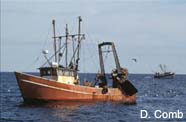
Small stern trawler fishing. (Photo: David Comb/New England Biolabs)
|
bottom trawler - a fishing vessel that uses an open-mouthed fishing net drawn along the sea bottom. This type of fishing is destructive to shallow water and deep sea coral reef communities |
boundary - in ecology, the edge between different habitat types. If distinctive, a boundary can be considered a separate edge habitat or ecotone. Boundaries that are readily crossed by an organism are called permeable, those that are crossed reluctantly are called semipermeable, and those that are not crossed are called impermeable |
boundary current - a large-scale water stream in the upper ocean which separates water masses |
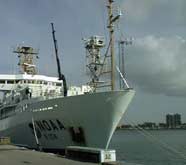
The Facing the bow of the NOAA Ship Ronald H. Brown (Photo: NOAA)
|
bow - the front part of a vessel |
box jellyfish - cnidarians belonging to the class Cubozoa, named for their cube-shaped or box-shaped medusae. Box jellyfish, also known as "sea wasps" are known for the extremely toxic venom produced by their stinging cells (nematocysts). They are responsible for over 5,000 deaths of humans. Box jellyfish are found in warm Australian waters, the Philippines, Southeast Asia, Hawaii and other places in the tropical Pacific Ocean. The box jellyfish is the only jellyfish with an active visual system, possessing clusters of simple and complex photoreceptors on each of the four sides of the bell. It is not known how their simple nervous system processes this information |
Boyle's Law - if the temperature is kept constant, the volume of a given mass of gas is inversely proportional to the absolute pressure |
bp (base pairs) - pairs of nucleotide bases in DNA |
brachial - pertaining or belonging to the arm |
brachial canal - a canal in the oral arms of scyphozoan medusae |
brachidium - in brachiopods (lamp shells), the internal skeleton (a long ribbon or loop-shaped calcified brachial support) for the lophophore |
brachiolaria larvae - a starfish larval stage following the bipinnaria stage. It has projecting arms and a developed stomach |
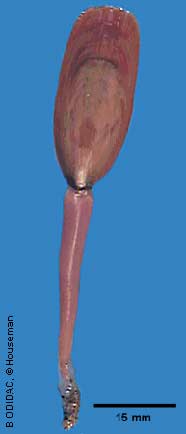
General view of the external features of a brachiopod. The valves (shells) are positioned dorsal and ventral. In bivalve mollusks, the valves are positioned right and left. (Photo: BIODIDAC)
|
Brachiopoda - a phylum of marine invertebrates that superficially resemble bivalve mollusks because of their hinged bilaterally symmetrical shells.They are commonly known as "lampshells" |
brachy- - a prefix from the Greek, meaning "short" |
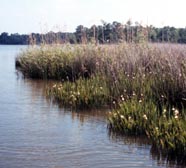
A brackish water area showing a mix of salt and freshwater marsh species in the Weeks Bay National Estuarine Research Reserve, AL. (Photo: NOAA)
|
brackish - mixed fresh and salt water |
brady - a prefix meaning "slow" |
bradyauxesis - a form of heterauxesis in which the growth process of a part is less than that of the whole |
bradycardia - an unusually slow heart rate |
bradytelic - an exceedingly slow rate of evolution manifested by slowly evolving lineages which survive much longer than would be expected. Possibly the best example of bradytelic evolution is the brachiopod, Lingula, which arose in the Cambrian and persists today |

Brain corals are so named because their surface resembles a mammalian brain. (Photo: David Burdick)
|
brain coral - species of scleractinian (hard or stony) corals which are characterized by their spherical shape and human brain-like appearance, with furrows and grooves. Brain corals are found in warm-water coral reefs in all the world's oceans. There are several species of brain corals found in two families |
branchia - a respiratory organ, such as a gill; a ctenidium |
branchial - pertaining to gills |
branchial aperture - the exterior opening of a gill chamber |
branchial chamber - in crustaceans, the area between the body and carapace which encloses the respiratory organs (gills) |
branchial cleft - a gill slit, such as is found in sharks, skates, and rays |
branchial crown - in marine polychaete worms, a structure surrounding the mouth composed of ciliated, bipinnate filaments which function in suspension filter feeding and respiration |
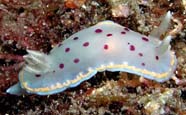
The feathery structure toward the posterior of this nudibranch gastropod (marine sea slug) is its respiratory organ.
|
branchial plume - a respiratory structure or external gills, usually located on the dorsal side toward the posterior of dorid nudibranchs. This plume surrounds the anus and in some species, it may be retracted. The branchial plume is the major respiratory structure in nudibranchs; in marine polychaete worms, a structure surrounding the mouth composed of ciliated, bipinnate filaments which function in suspension filter feeding and respiration |
branchial siphon - the incurrent siphon in some mollusks |
branchiform - gill-shaped |
branching colony - a coral growth pattern where branches are formed |
branchiocardiac groove - in decapod crustaceans, a groove on each side of the carapace which separates the branchial and cardiac regions |
branchiopallial - pertaining to the gill and mantle of mollusks |
branchiostegal - one of the dermal bony or cartilaginous struts that support the branchiostegal membranes of fishes. Sometimes called branchiostegal rays, but not to be confused with the fin rays |
branchiostegal area - in crustaceans, the part of the carapace which extends laterally and ventrally over the gills |
Braun-Blanquet method - a method for estimating seagrass and other plant species composition. It involves identifying all species represented in a specific quadrat, then assigning each a code based on its contribution to the total area. An example of Braun-Blanquet codes is: 0: species not present; 1: species <5% of total; 2: species=5-10% of total; 3: species=10-25% of total; 4: species=25-50% of total; 5: species=50-90% of total; 6: species>90% of total |
Bray-Curtis similarity coefficient - a similarity coefficient used to determine site similarities based on organism abundances. It is widely employed in multivariate analysis of assemblage data. It reflects differences between two samples due both to differing community composition and/or differing total abundance |
breaker - a wave that approaches shallow water, causing the wave height to exceed the depth of the water, in effect tripping it. The wave changes from a smooth surge in the water to a cresting wave with water tumbling down the front of it; a wave breaking on the shore |
breaker zone - the area of a coral reef most exposed to breaking waves |
breast - in fishes, the anterior ventral surface under the head |
breed - a group of organisms, usually infrasubspecific, related by descent from common ancestors and visibly similar in most characteristics. A species can have numerous breeds; a population of a species that has distinct characteristics that differentiate them from other populations in that species. Reproduction within the population produces offspring which are recognizable as members of that population. Breeds can further be subdivided into varieties based on differences within the breed |
breeding season - the time of the year during which mating occurs |
breeding season - that period of a year in which organisms are sexually active |
brevilingual - having a short tongue |
brine - water that contains a high concentration of salt |
brine pool - concentrations of water on the ocean floor which have an extremely high salinity relative to the surrounding water. Brine pools are caused by salt tectonics, which is the process by which large deposits of salt are moved by geological forces. Cold seep activity often coincides with the location of a brine pool |
bristle - a stiff, coarse, hair-like structure |
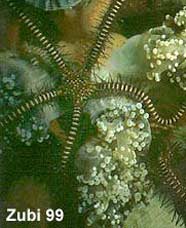
This black brittle star (Ophiomastix variabilis) is an inhabitant of Indo-Pacific coral reefs. (Photo:Teresa (Zubi) Zuberbühler (www.starfish.ch))
|
brittle star - brittle stars are echinoderms (class Ophiuroidea) which are closely related to sea stars (starfish). They possess radial symmetry with a central body disc from which five highly flexible snake-like arms protrude. There is no replication of internal organs,as in the arms of sea stars, just one set in the central disk. Compared to starfish, brittle stars have a much smaller central disc and no anus. Wastes are eliminated through the mouth, which is situated on the undersideof the disc. The name is derived from their arms breaking off as a means of defense. New arms are easily regenerated. They are also called serpent stars because of the snakelike movements of the five arms |
brittlestar city - a huge assemblage of brittlestars on the Macquarie Ridge seamount. Macquarie Ridge stretches 1,400 km south from New Zealand to just above the Antarctic Circle. A multi-disciplinary scientific team from New Zealand and Australia discovered a community of tens of millions of brittlestars (relatives of starfishes) living "arm tip to arm tip" in the swirling Antarctic Circumpolar Current flowing over and around the peak of the seamount at roughly four kilometers per hour. This current allows the filter-feeding brittlestars to capture passing food simply by raising their arms. The current sweeps away fishes and other hovering would-be predators. Brittlestar city is unusual because corals and sponges usually dominate seamount peaks, filtering food that arrives on the current |
broadcast spawner - an organism that releases gametes directly into the sea for external fertilization |
brood - all of the offspring that hatch from a single clutch of eggs or the offspring of a single birth that normally mature at about the same time; to incubate eggs |
brood pouch - a sac-like cavity in the parent's body in which eggs are deposited and fertilized and larvae develop, such as in seahorses; marsupium; brood chamber |
brooder - a coral which harbors or broods developing larvae within its polyps |
brooding - the development of larvae within the gastrovascular cavity of an adult coral polyp |
brooding - parental care of young |
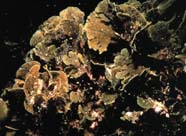
Brown algae. (Photo: NOAA)
|
brown algae - brown algae belong to the Division Phaeophycophyta, whose approximately 1,500 species are almost exclusively marine. They include the largest of the seaweeds and the kelps. The brown algae have chlorophyll a and c, as well as carotenes and xanthophylls, but the green chlorophyll coloration is masked by the brown and yellow pigments. Brown algae are among the largest photosynthetic organisms on earth. The largest kelps may grow to more than 60 meters in length, forming dense underwater forests in colder waters. Many microscopic brown algae grow as epiphytes on underwater vegetation, forming networks of branched filaments, or broad encrustations. All species are multicellular and do not form colonies. Their life cycles are complex, involving alternation of generations. In general, they are not free-floating organisms, but are attached to rock, coral, or other firm surfaces. Sargassum weed, however, is a floating brown algae that stays afloat by producing gas-filled bladders |
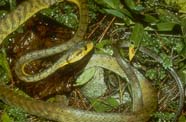
The brown tree snake (Boiga irregularis) is an invasive species that has caused great ecological and economic damage on Guam. (Photo: U. S. Geological Survey)
|
brown tree snake - the mildly venemous brown tree snake (Boiga irregularis) is an introduced species on some Pacific islands that has become a serious pest, especially on Guam. In the absence of natural population controls and with vulnerable prey on Guam, the snakes have become an exceptionally common pest causing major ecological and economic problems. The snakes probably arrived on Guam hidden in ship cargo from the New Guinea area. By 1968, they had dispersed throughout the island and caused havoc by virtually wiping out Guam's native bird species and helped decimate their fruit bat populations. In addition to Guam, brown tree snakes have been sighted on Saipan, Tinian, Rota, Kwajalein, Wake, Oahu, Pohnpei, Okinawa, and Diego Garcia. To date, this snake is not known to be established on any of these islands except Guam |
browser - a software program, such as Netscape Navigator or Microsoft Internet Explorer, that allows one to view pages on the Internet |
brumation - a long period of torpor or rest induced by cold temperatures in reptiles and other cold-blooded animals. Brumation is similar to hibernation in warm-blooded animals |
brunneous - dark brown color |
brush - a cluster of bristles |
bryostatin - a marine pharmaceutical, isolated from bacteria living in the bryozoan Bugula neritina, having anti-cancer and immune system modulating properties |
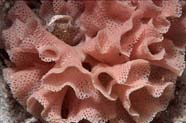
Bryzoa colony.
|
Bryozoa - an animal phylum synonymous with Ectoprocta that contains approximately 5,000 living species. They are all sessile colonial forms composed of zooids. Zooids are tubular, oval or box-like structures that contain a lophophore, which is a circular or horseshoe-shaped fold of the body wall that encircles the mouth and bears numerous ciliated tentacles. Most species form erect or encrusting colonies. They occur in many different habitats, including coral reefs |
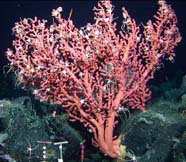
Bubble gum coral on Gulf of Alaska Seamounts. (Photo: NOAA Ocean Explorer )
|
bubblegum coral - a deep water gorgonian, Paragorgia arborea, found in the North Pacific and North Atlantic Oceans at depths that may exceed 1400m. It can grow to 5m in height and 8 m in width. It is called the bubblegum coral because because it is usually orange or pink in color, and has a lumpy surface texture |
buccal - pertaining to the cheek or oral cavity |
buccal cavity - the mouth or oral cavity |
buccal siphon - in tunicates, the opening through which water enters into the pharyngeal basket. It is also called the incurrent, inhalant, or oral siphon/canal |
buccopharyngeal - pertaining to the oral cavity and pharynx |
budding - a type of asexual reproduction in which new individuals develop from the parent organism, forming a swelling similar in appearance to a bud, which separates from the parent as it grows; budding is a form of asexual reproduction in corals where a parent corallite forms daughter corallites |

NOAA divers working in buddy pairs. (Photo: NOAA/National Undersea Research Program)
|
buddy - a scuba diving partner. For safe diving, a pair of divers (buddies) stay close to each other in order to offer assistance if needed |

Scuba divers practicing buddy breathing. (Photo: John Buchanan)
|
buddy breathing - two scuba divers sharing air from one second stage regulator |
buffer - a solution or liquid whose chemical makeup neutralizes acids or bases without a great change in pH |
buffer species - a species which may serve as an alternate food supply for a predator or consumer |
buffer zone - the region near the border of a protected area; a transition zone between areas managed for different objectives |
buffered solution - a chemical solution that resists changes in pH despite the addition of small amounts of acids or bases |
bulb - a rounded dilation or expansion in a canal, vessel, or organ |
bulbous - a rounded or swollen shape |
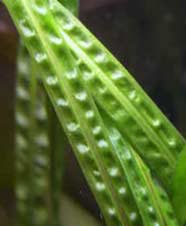
A leaf with bullate appearance (Photo: Shaun L. Winterton)
|
bullate - describes a blistered or puckered surface |
bulliform - blister or boil-shaped |
bulwark - the side of a ship above the deck |
buoy - a floating platform for navigational purposes or supporting scientific instruments that measure environmental conditions |
buoyancy - the tendency of object to float or sink when placed in a liquid. Positively buoyant objects float, negatively buoyant objects sink, and neutrally buoyant objects stay in place |
burrow - a hole or excavation dug in the substrate by an animal, usually for shelter, habitation, refuge, or to rear young |

A male fiddler crab (Uca pugnax) lives and mates in a burrow on the beach (Photo: NOAA)
|
burrower - an animal that makes a hole or burrow in the substratum and lives in it. For example, a fidler crab |
bursa - a sac or sac-like cavity |

The butterflyfish, Chaetodon vagabundus, photographed in the Solomons Islands (Photo: Photo: Tom Doeppner/Brown University)
|
butterflyfish - any species of colorful, oval-shaped, deep-bodied and strongly compressed spiny-rayed fishes in the family Chaetodontidae. They have small mouths with flexible, brush or comb-like teeth. They resemble the closely related angelfishes. They feed on a variety of foodstuffs from zooplankton to tiny crustaceans and mollusks, soft and hard corals, anemones, segmented worms, and other soft and encrusting invertebrates associated with coral reefs. Some species are omnivores that primarily feed on marine algae as well as animals, while others are obligate corallivores |
buttress - see spur and groove |
buttress zone - the seaward-sloping area of a coral reef (just beneath the algal ridge) that consists of alternating ridges and furrows |
bycatch - organisms taken in a fishery which are not of the species intended for harvest. For example, mammals or turtles captured in trawl or seine fishing |
bycatch reduction devise - equipment attached to commercial fishing equipment to reduce the amount of bycatch taken |
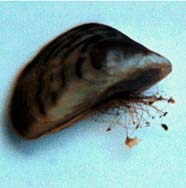
The byssal gland is located within the foot of the mussel. It produces secretions which are used to form byssal threads for attachment to substrates. (Photo: Great Lakes Sea�Grant Network Exotic Species Library, Ontario Ministry of Natural Resources)
|
byssal thread - one of many thin, hairlike filaments secreted by certain mollusks for attachment to a substrate |
byte - a memory and data storage unit composed of contiguous bits, usually eight. For example, file sizes are measured in bytes or megabytes (one million bytes). Bytes contain values of 0 to 255 and most often represent integer numbers or ASCII characters |
|
|
|
|

